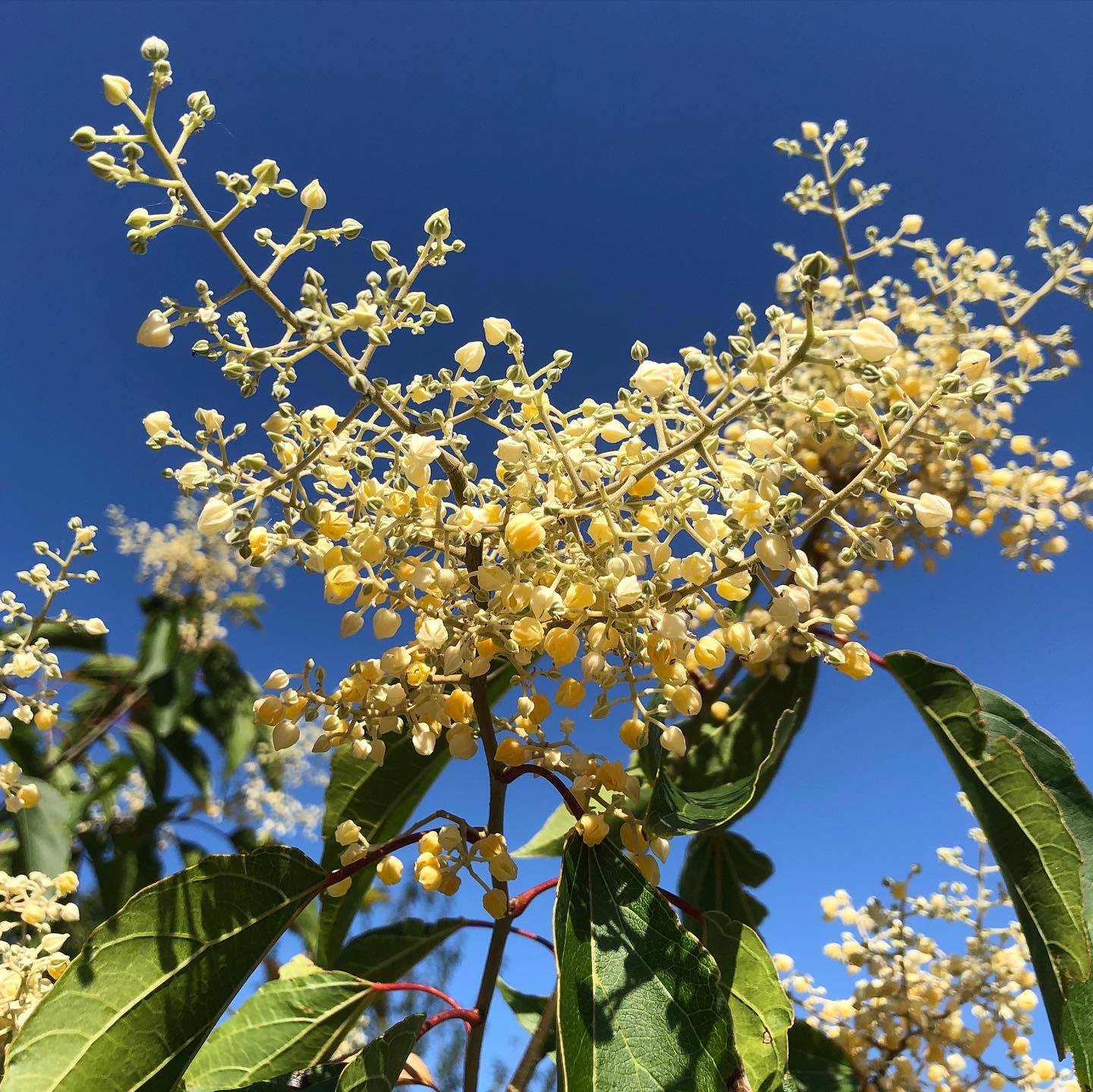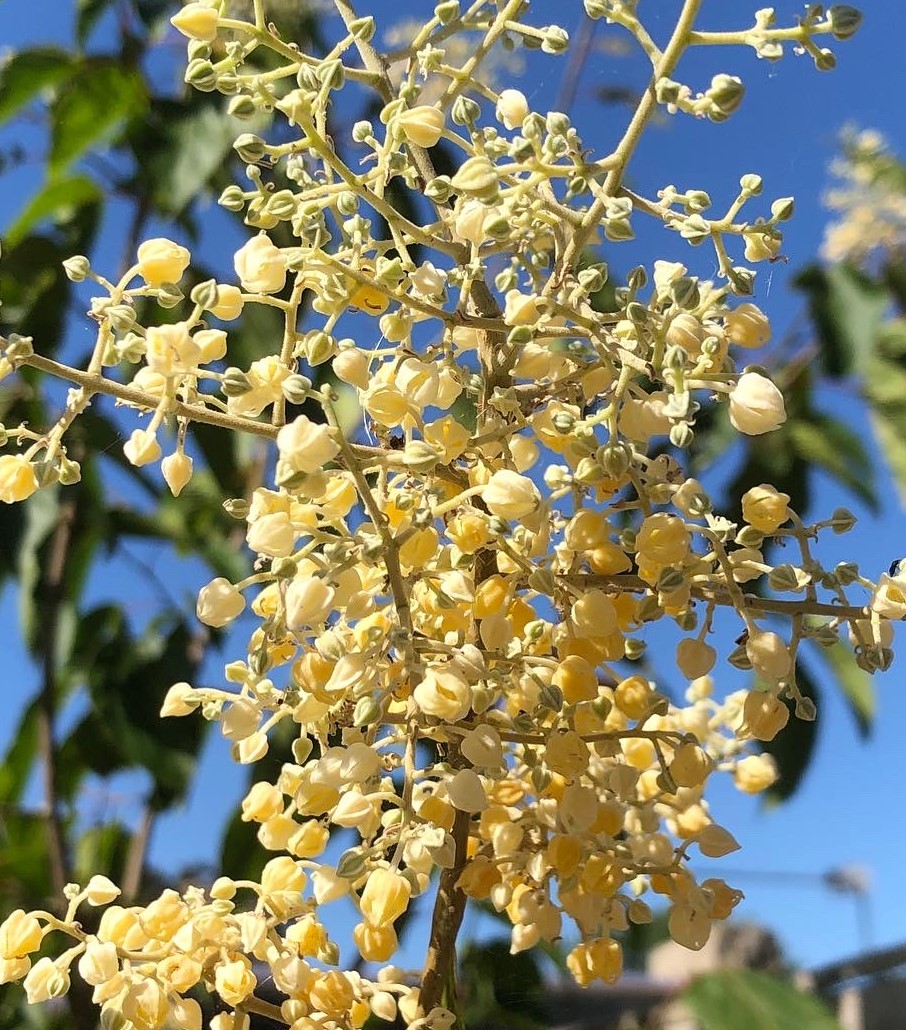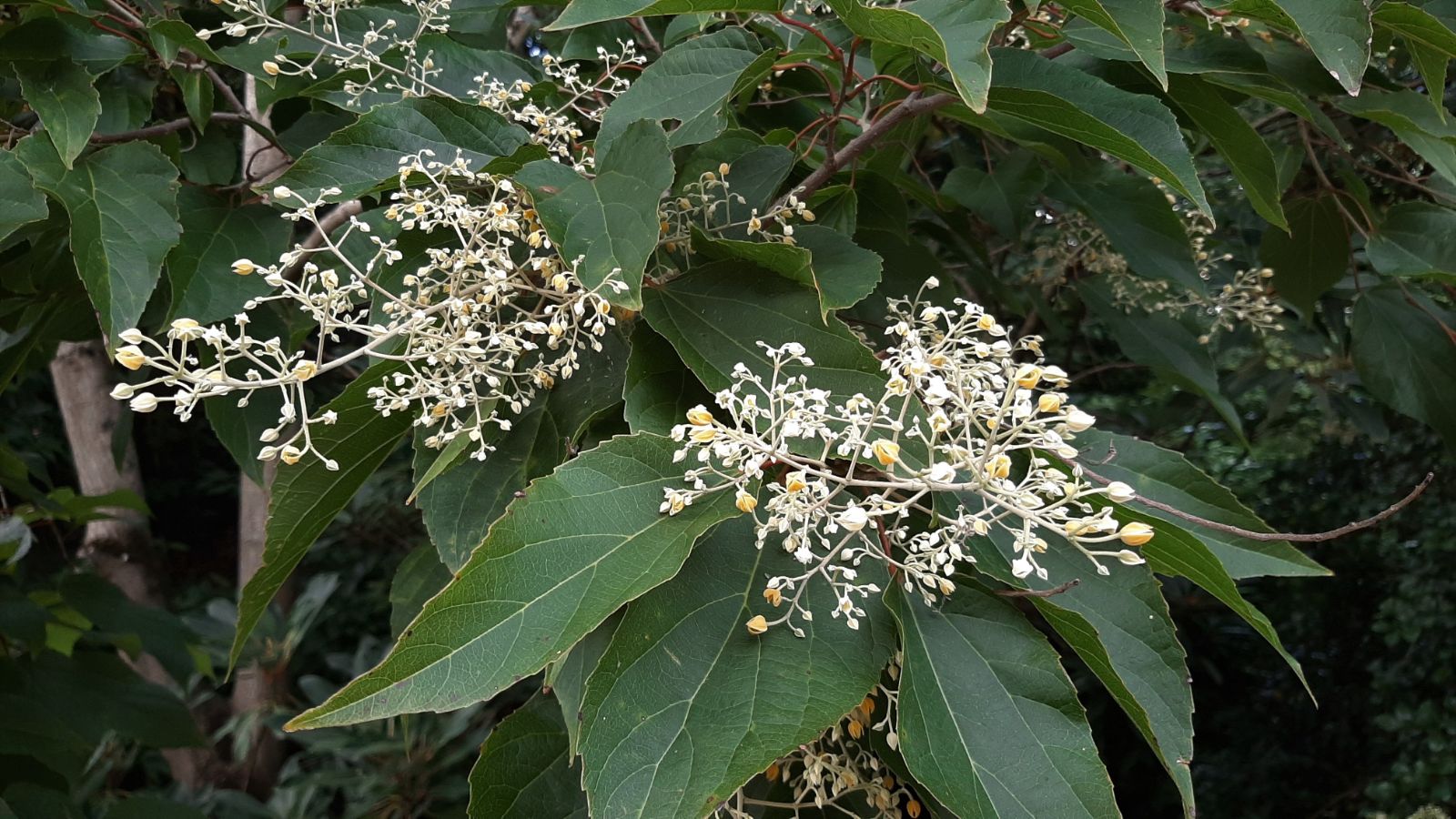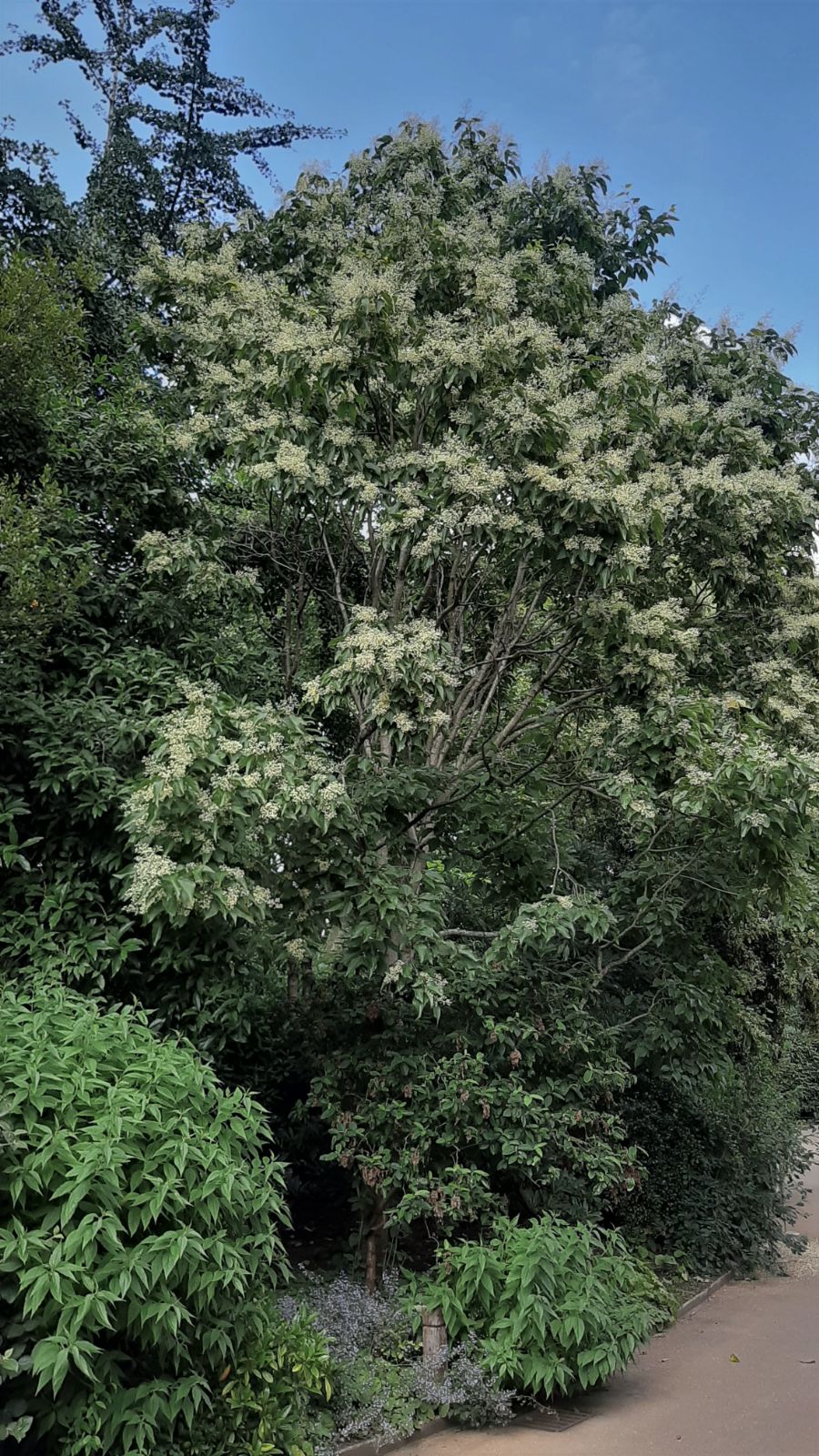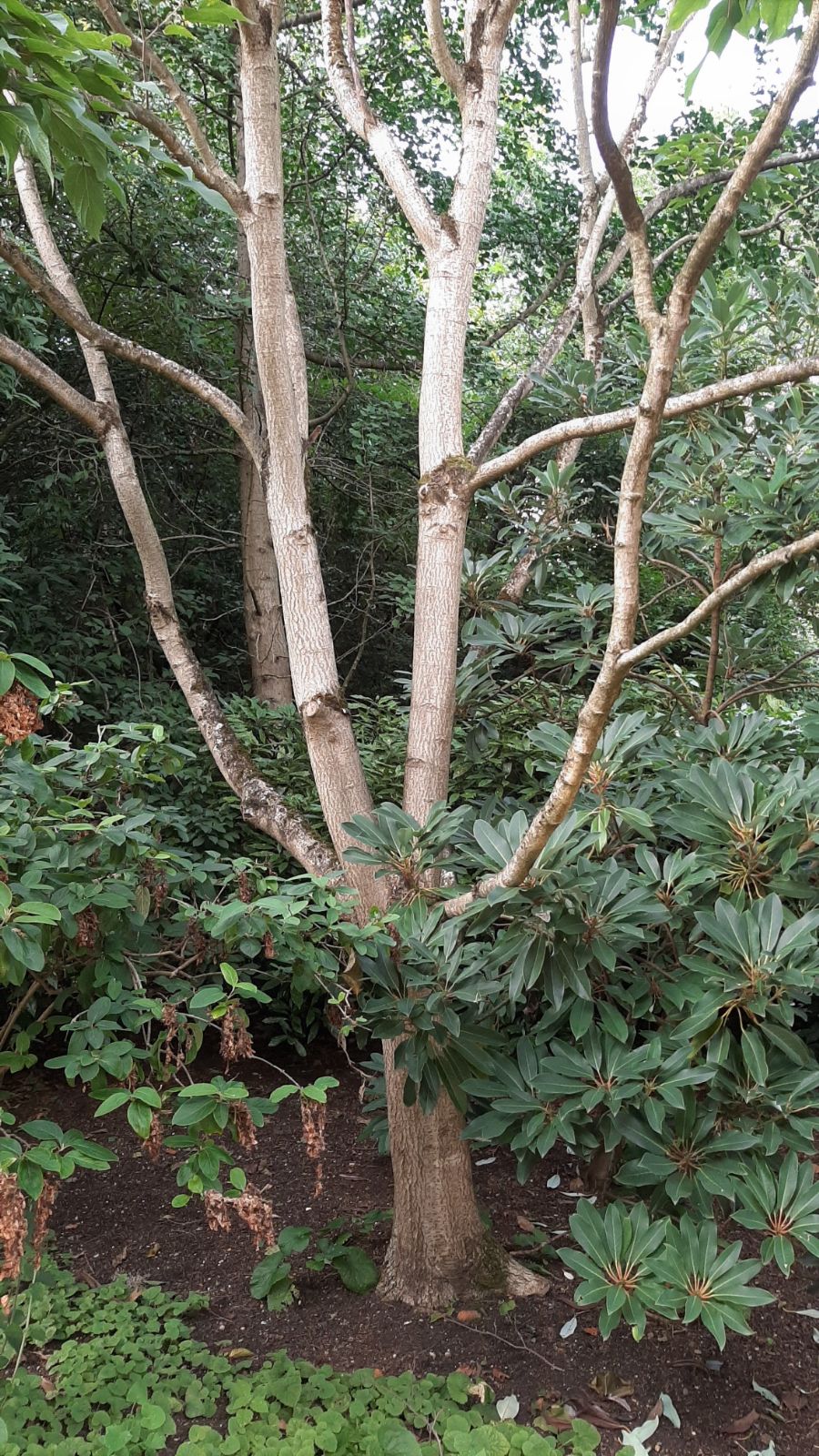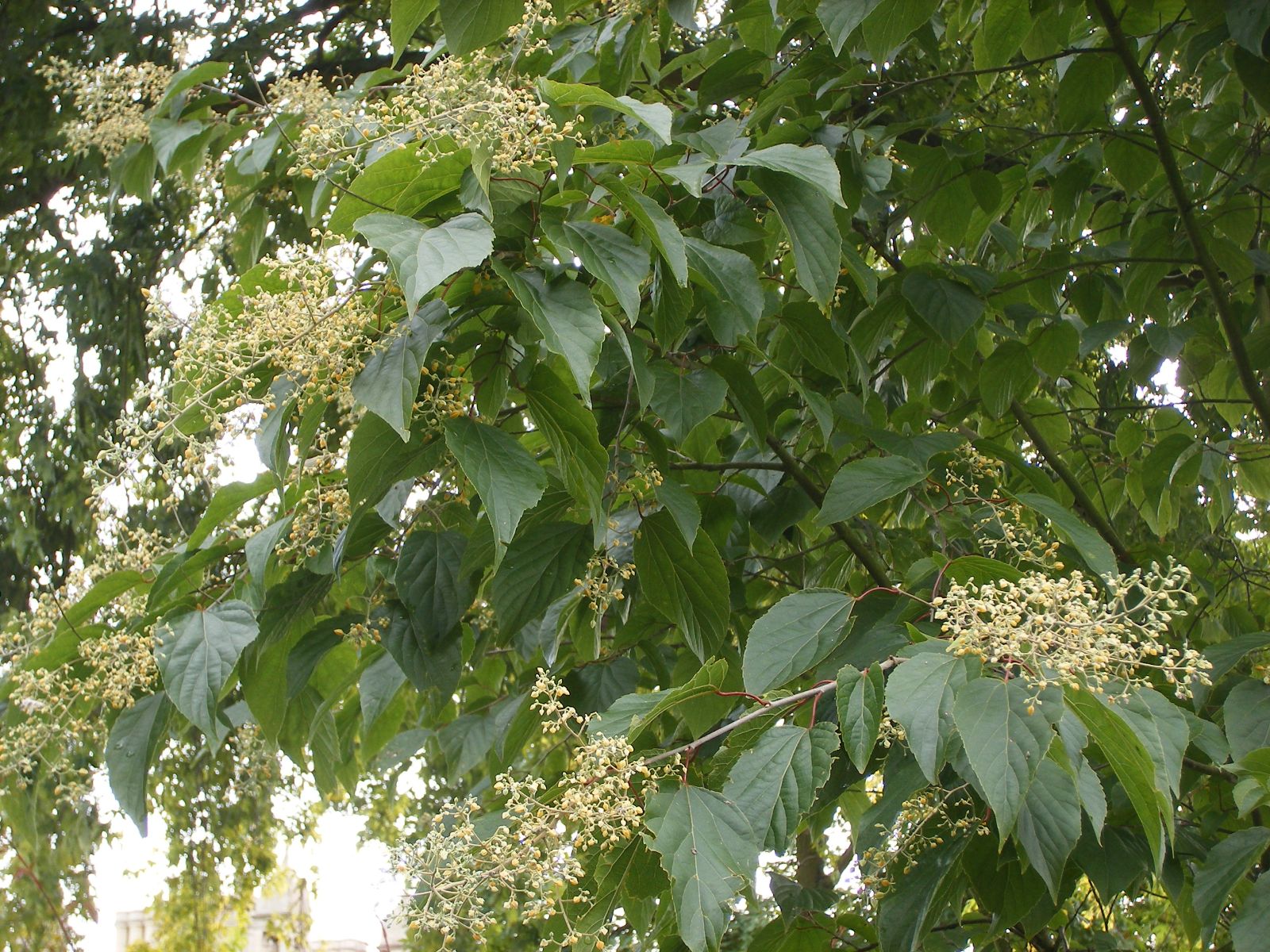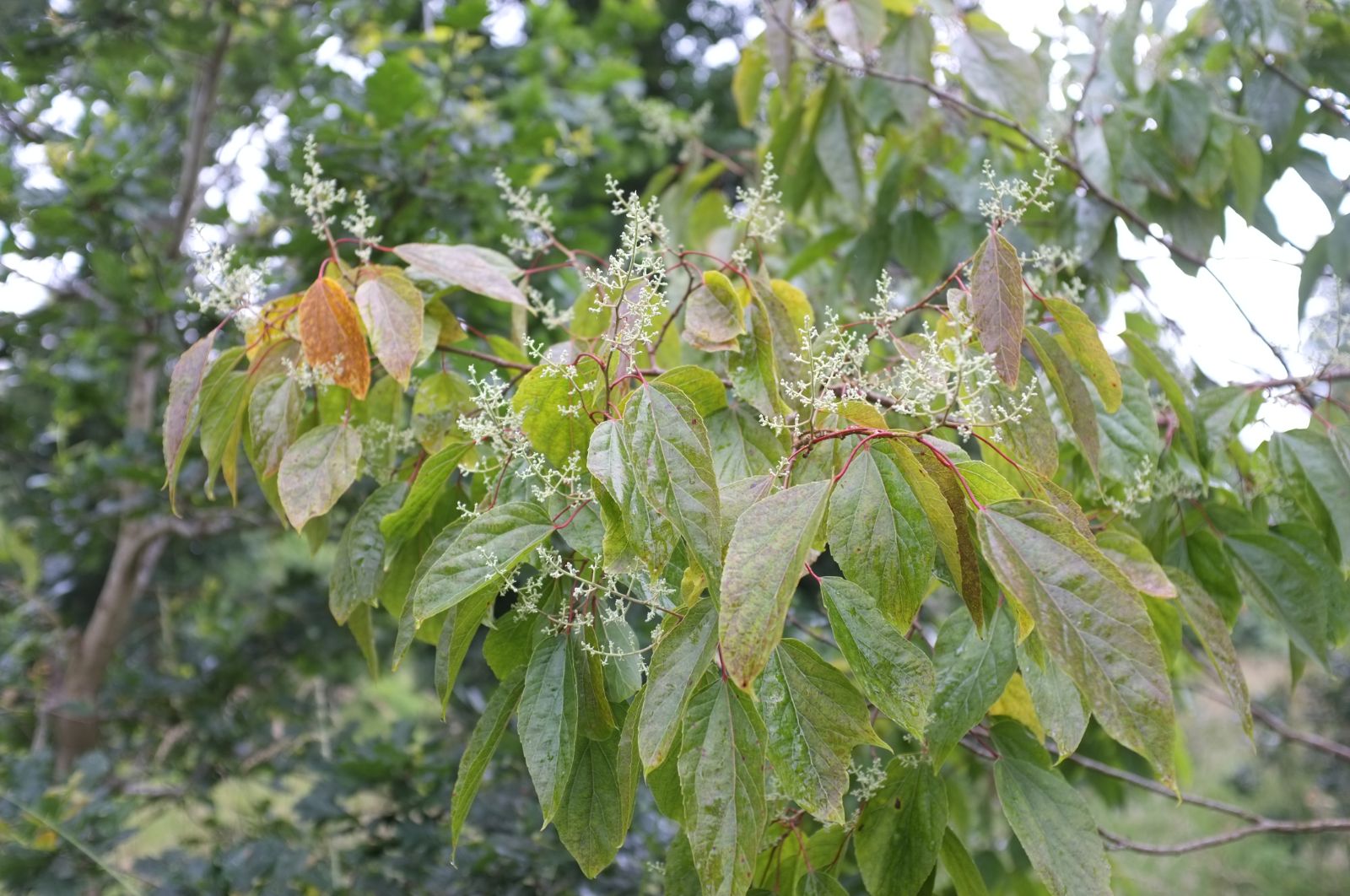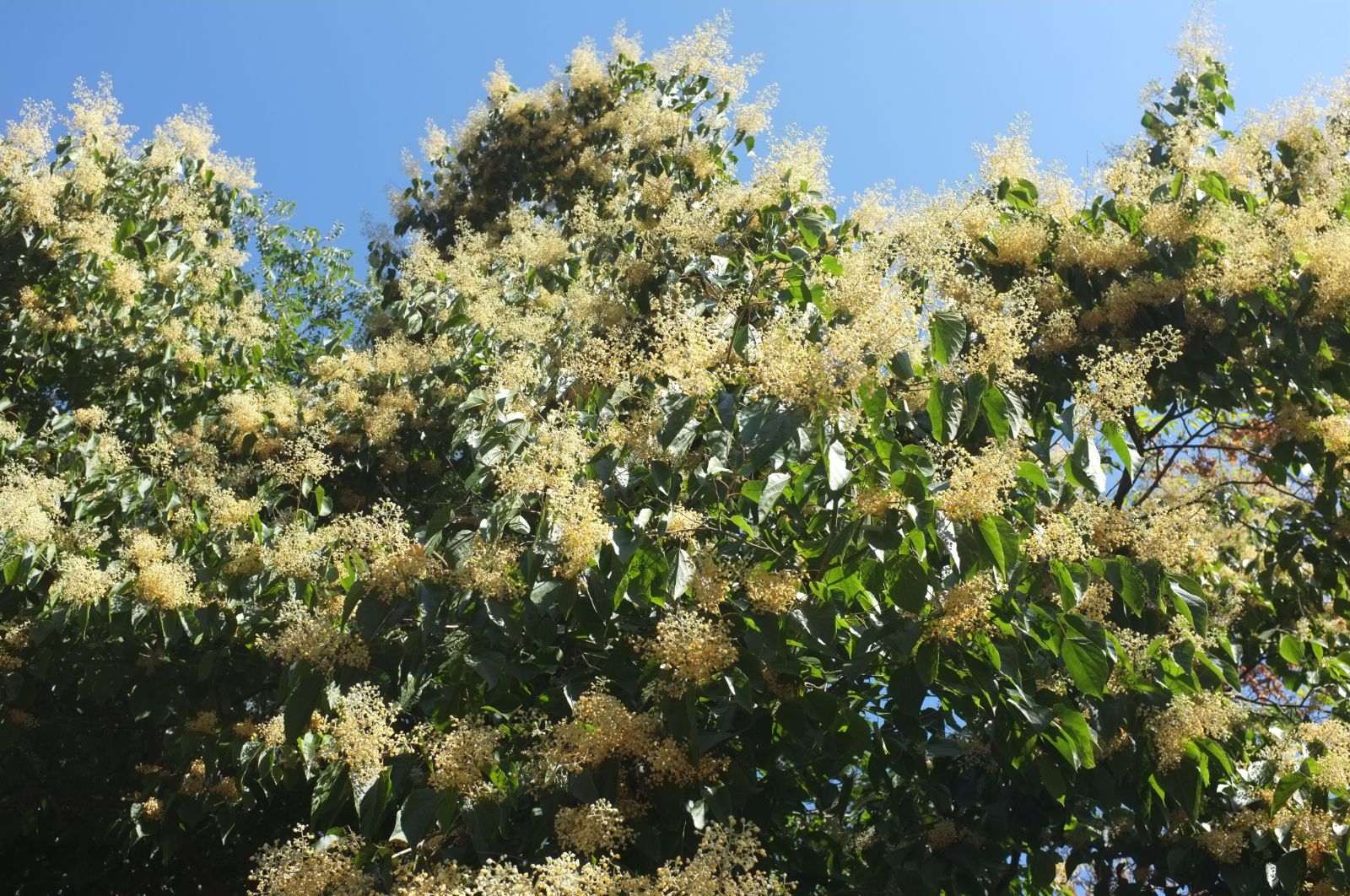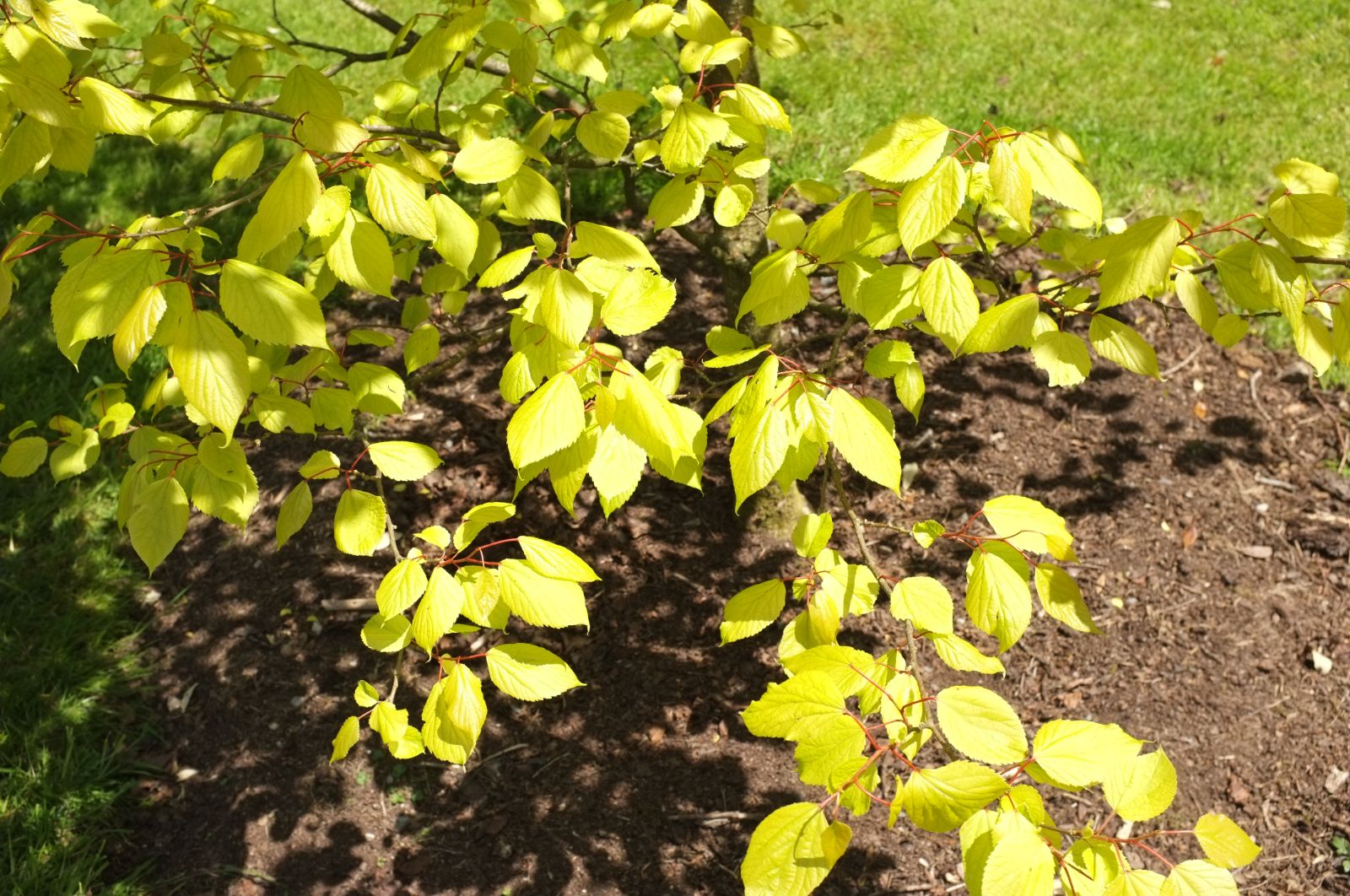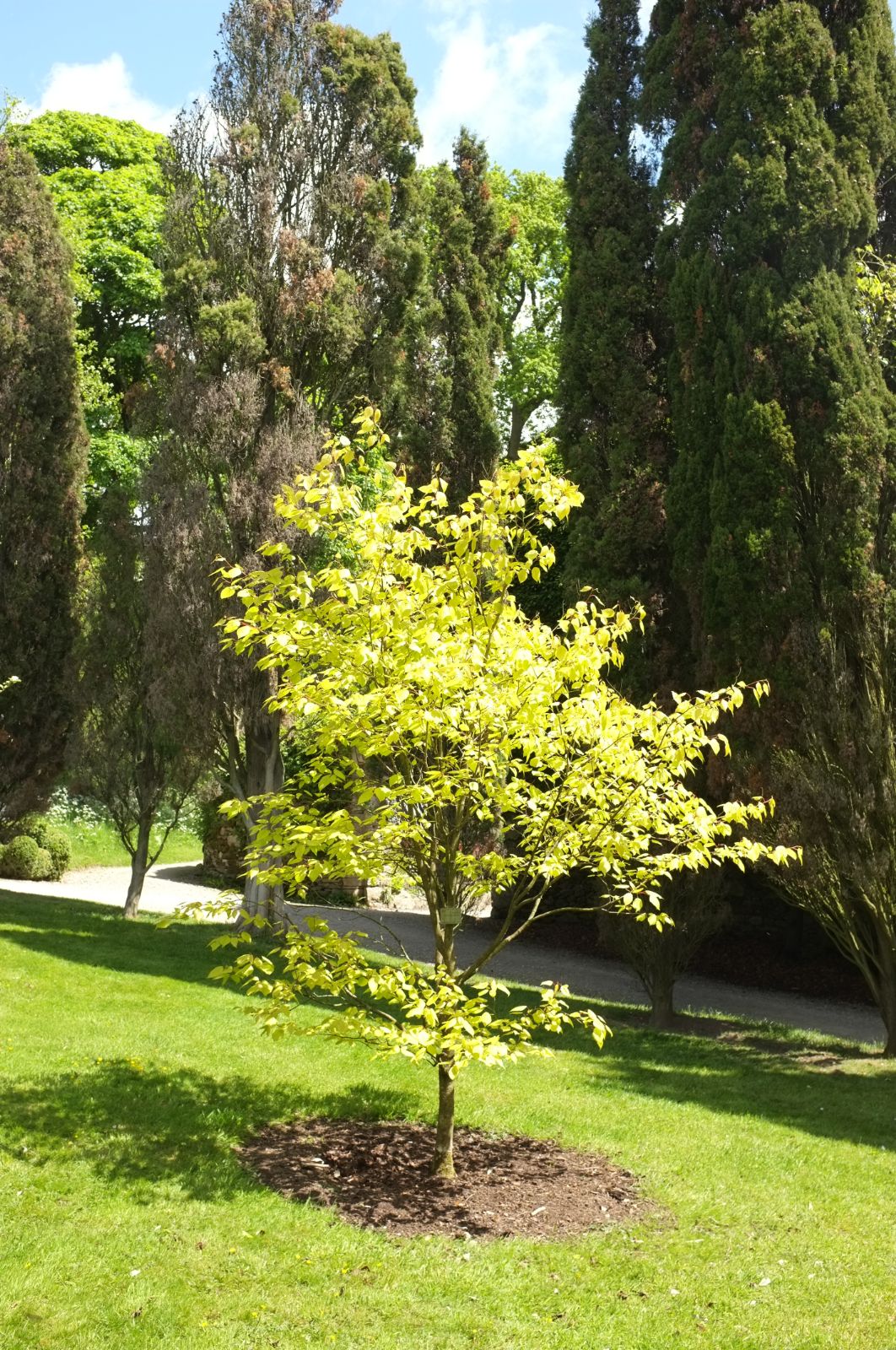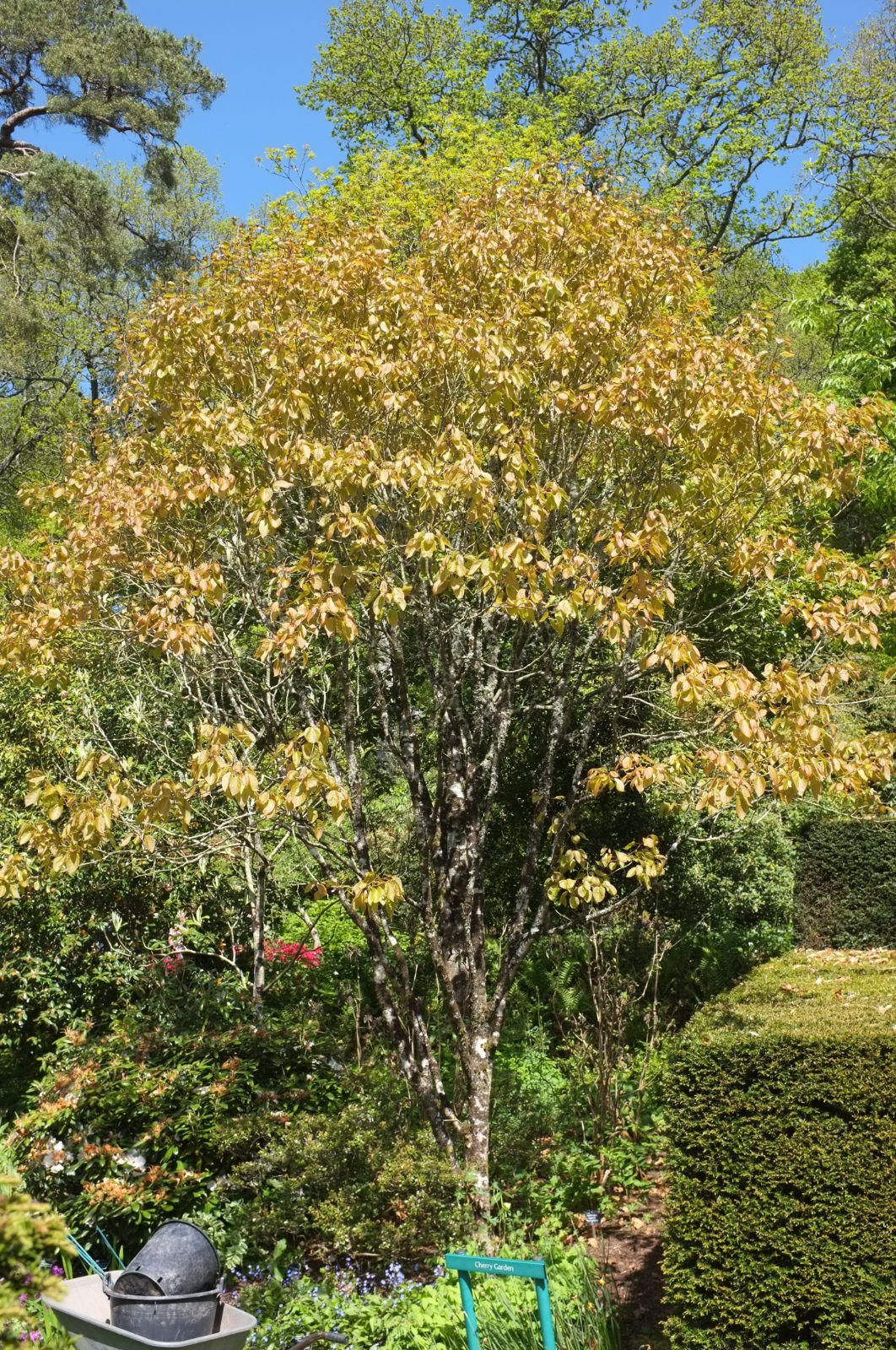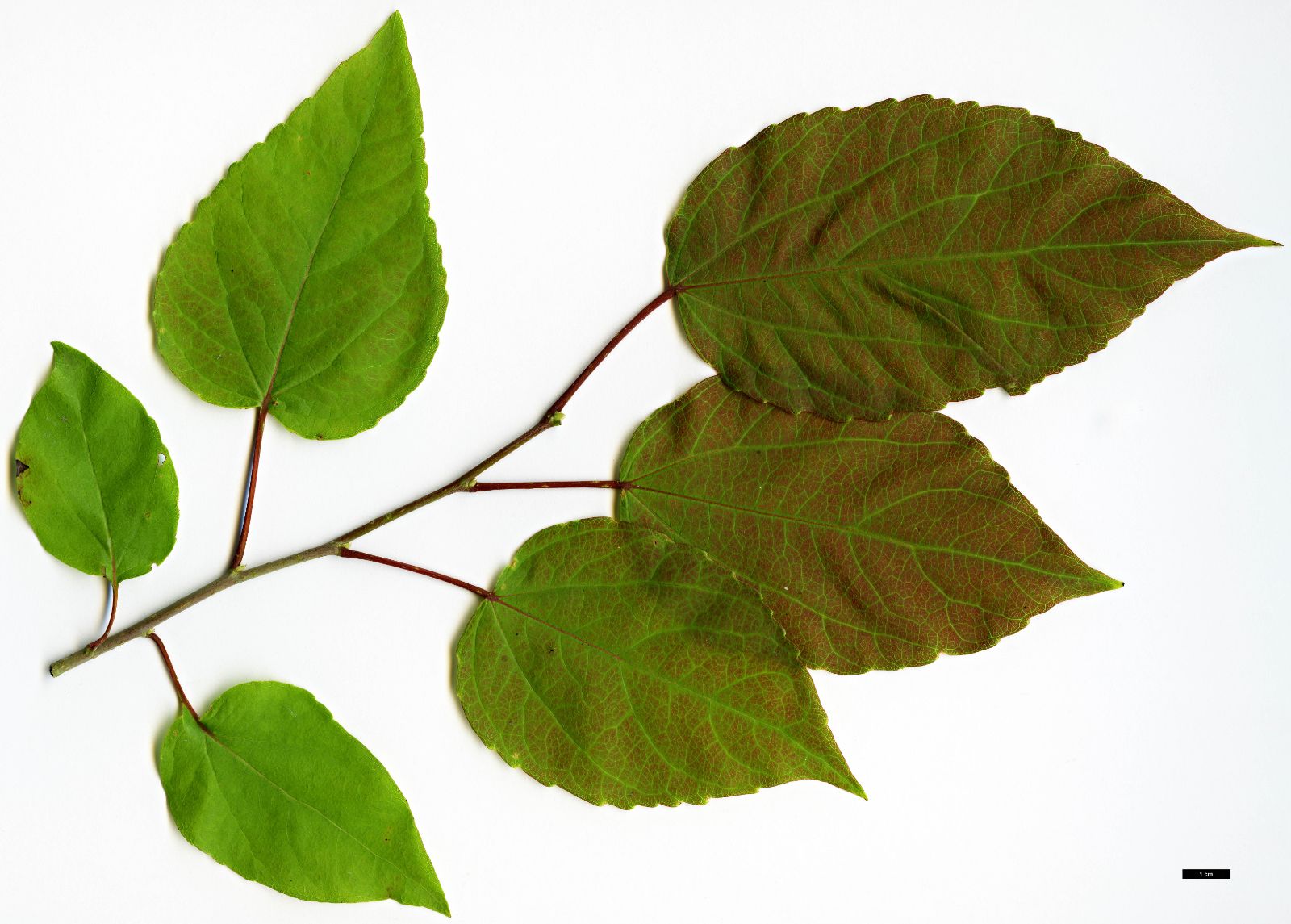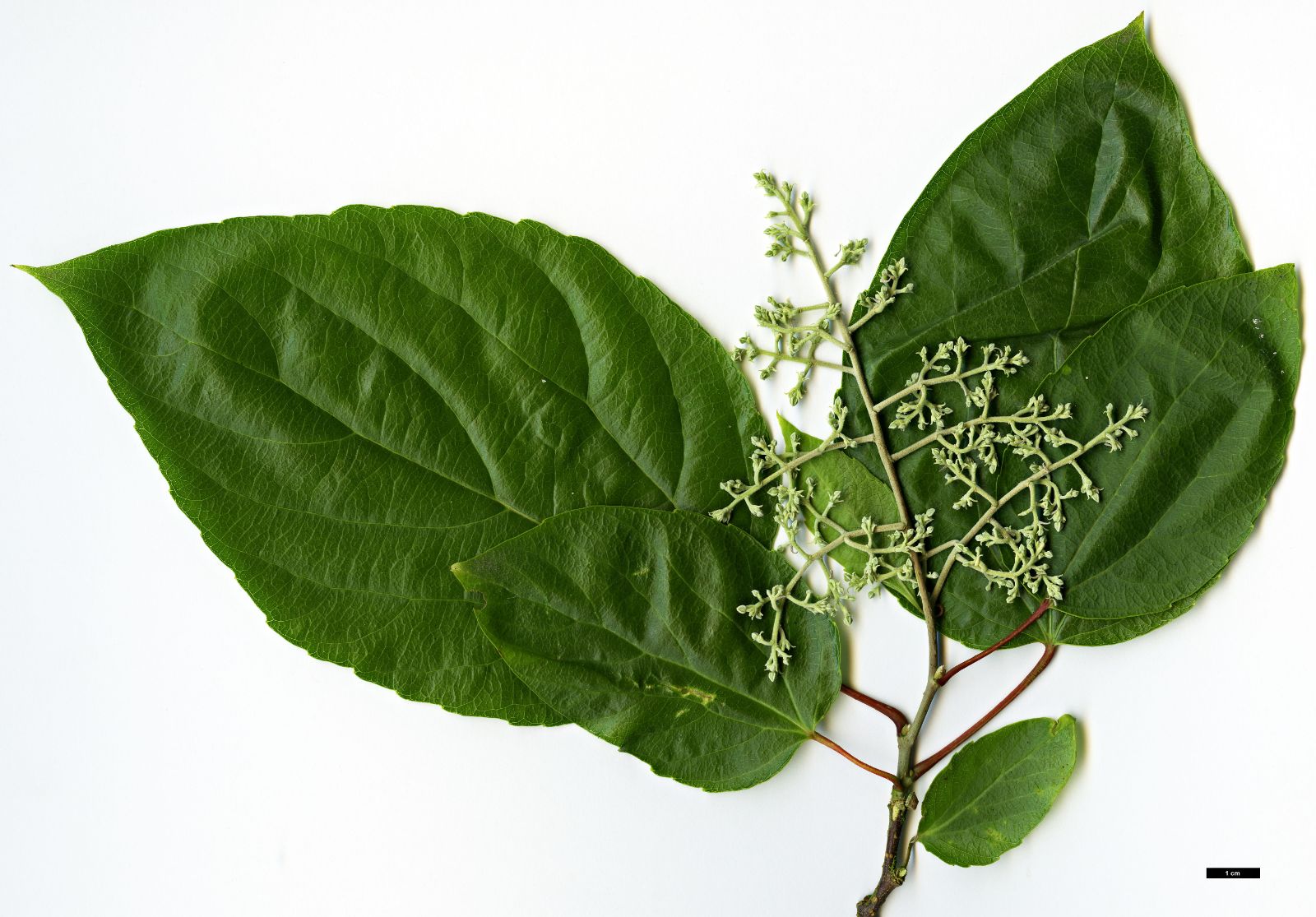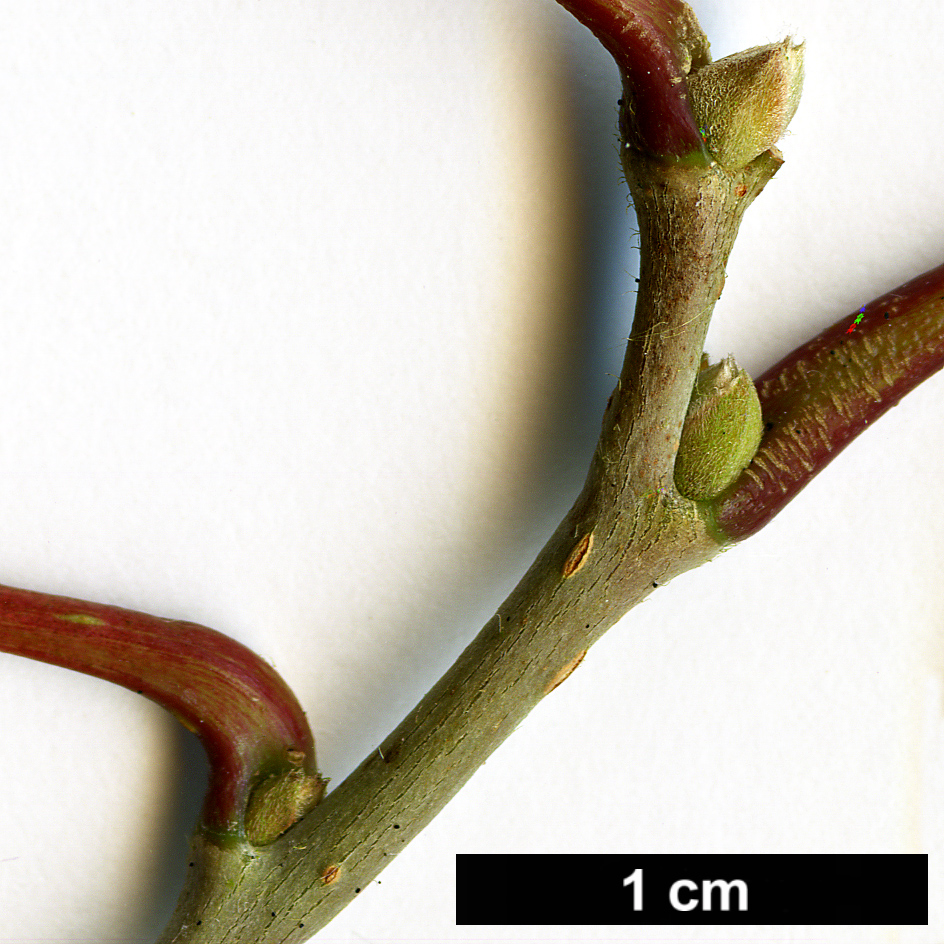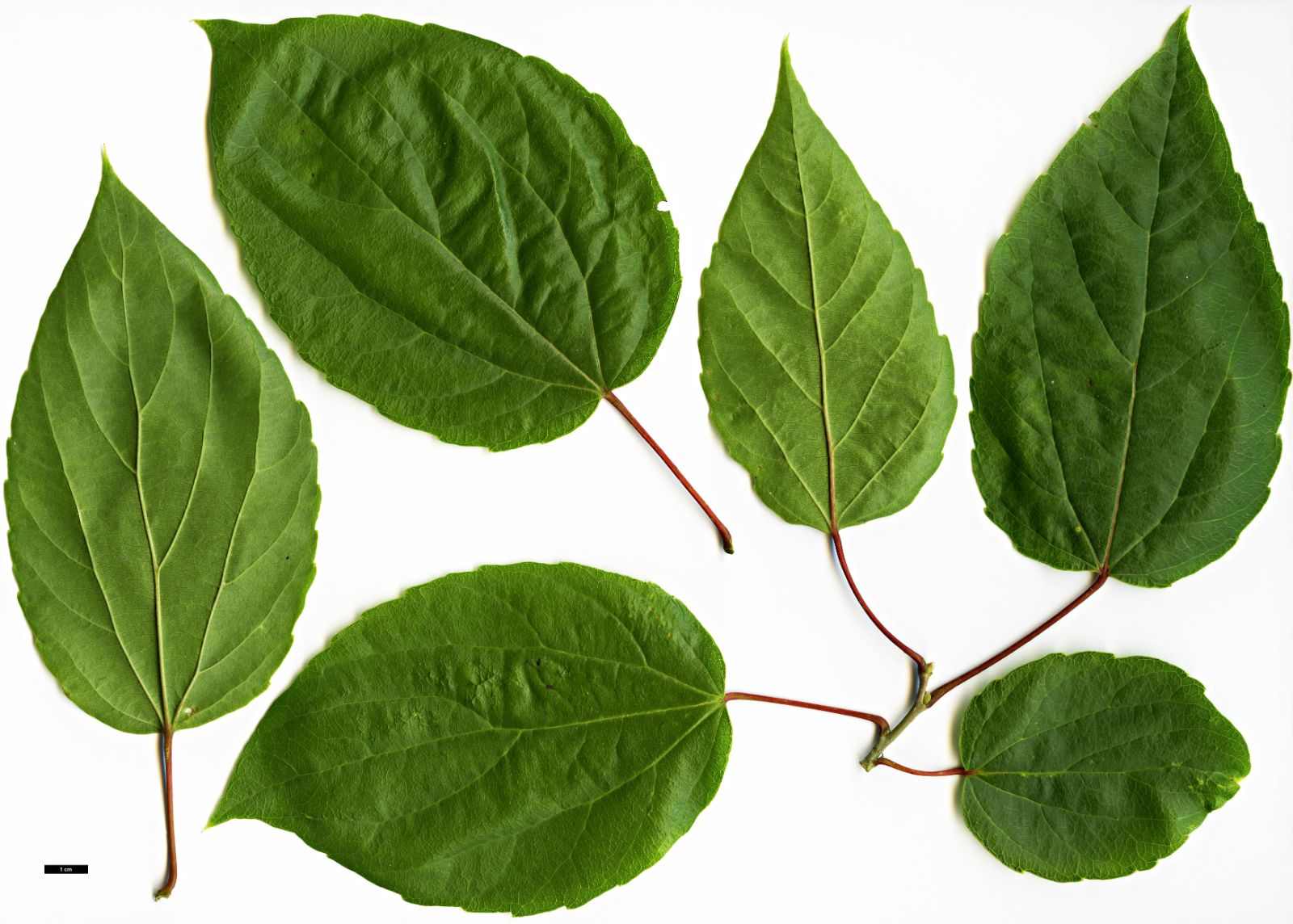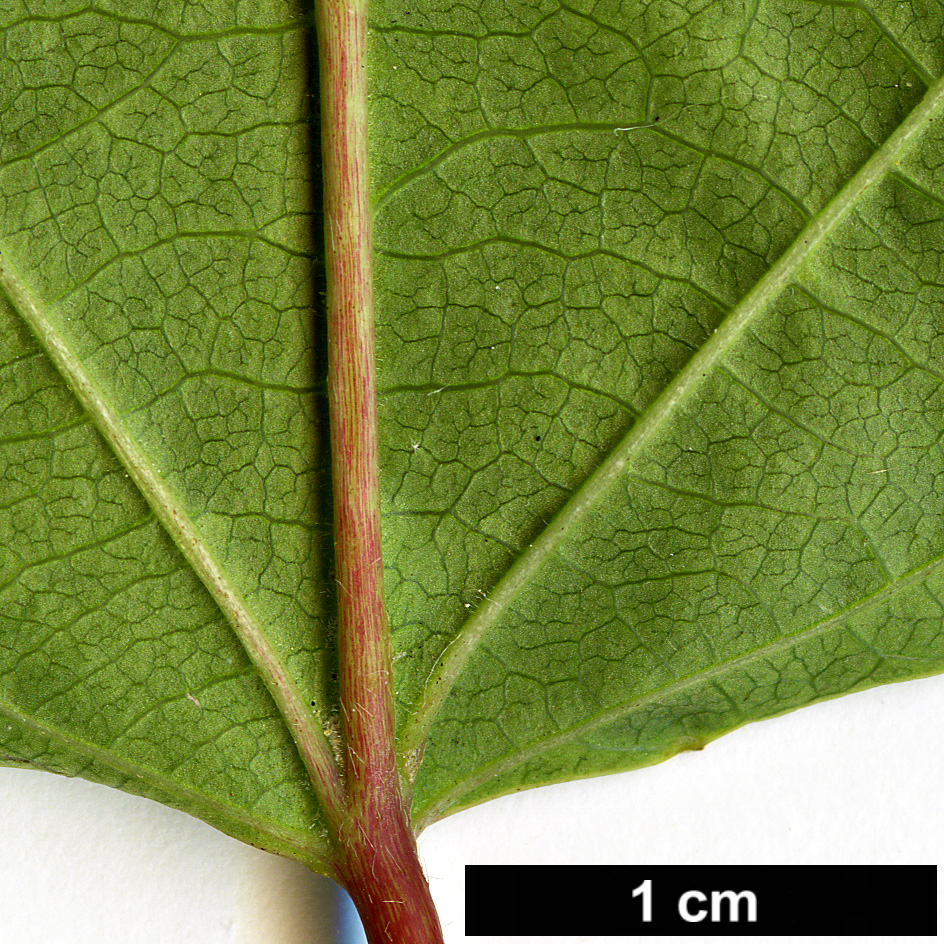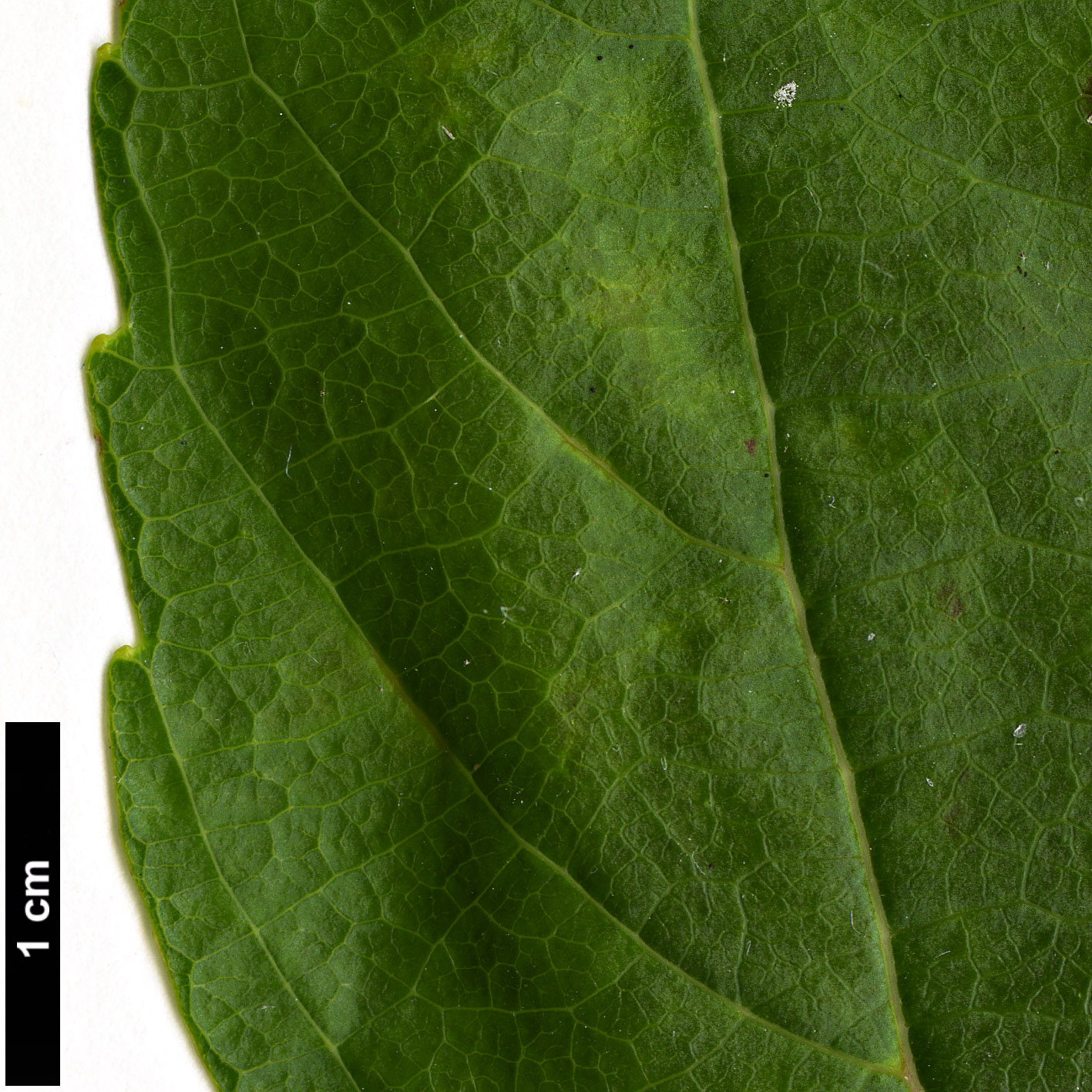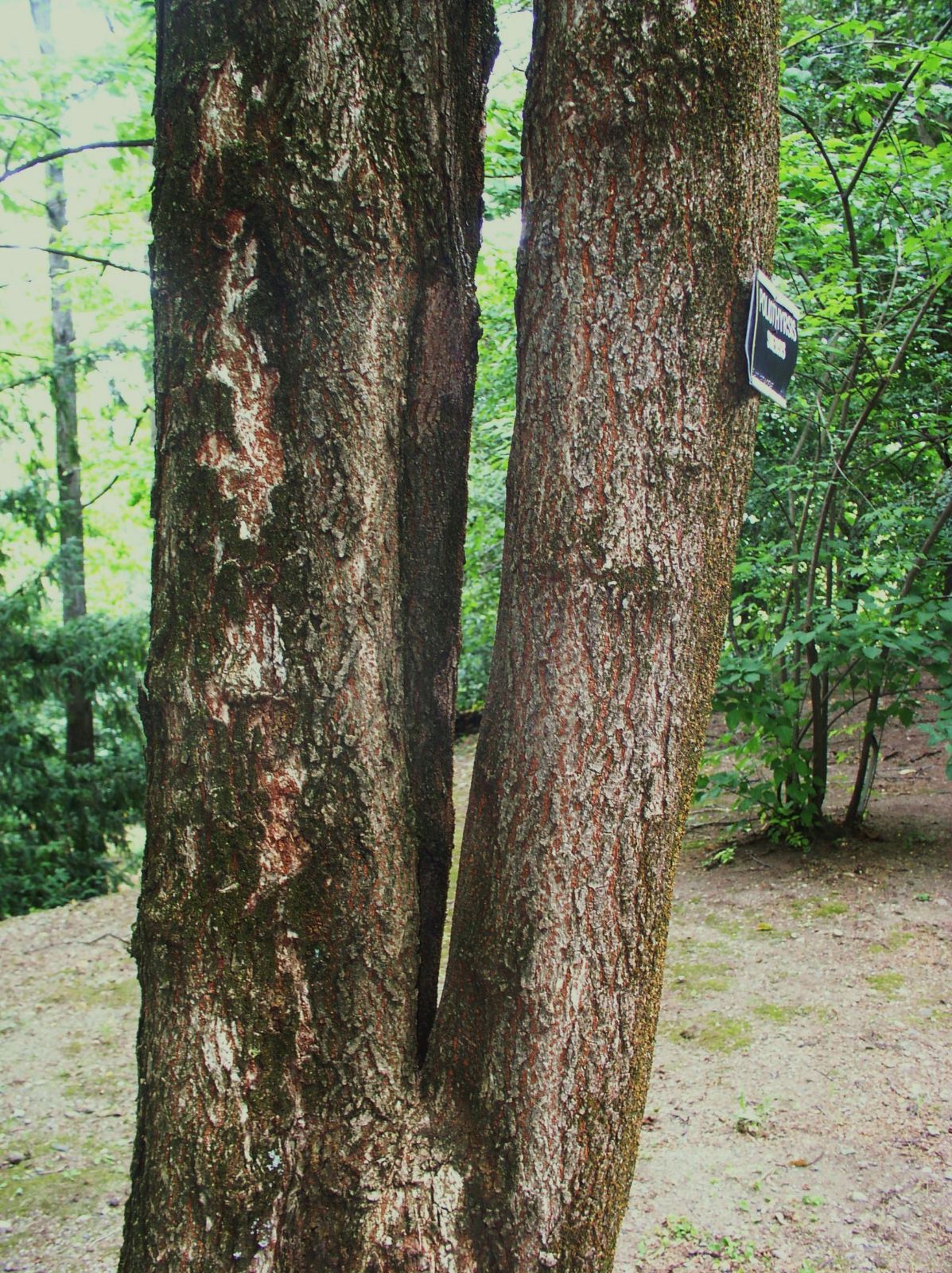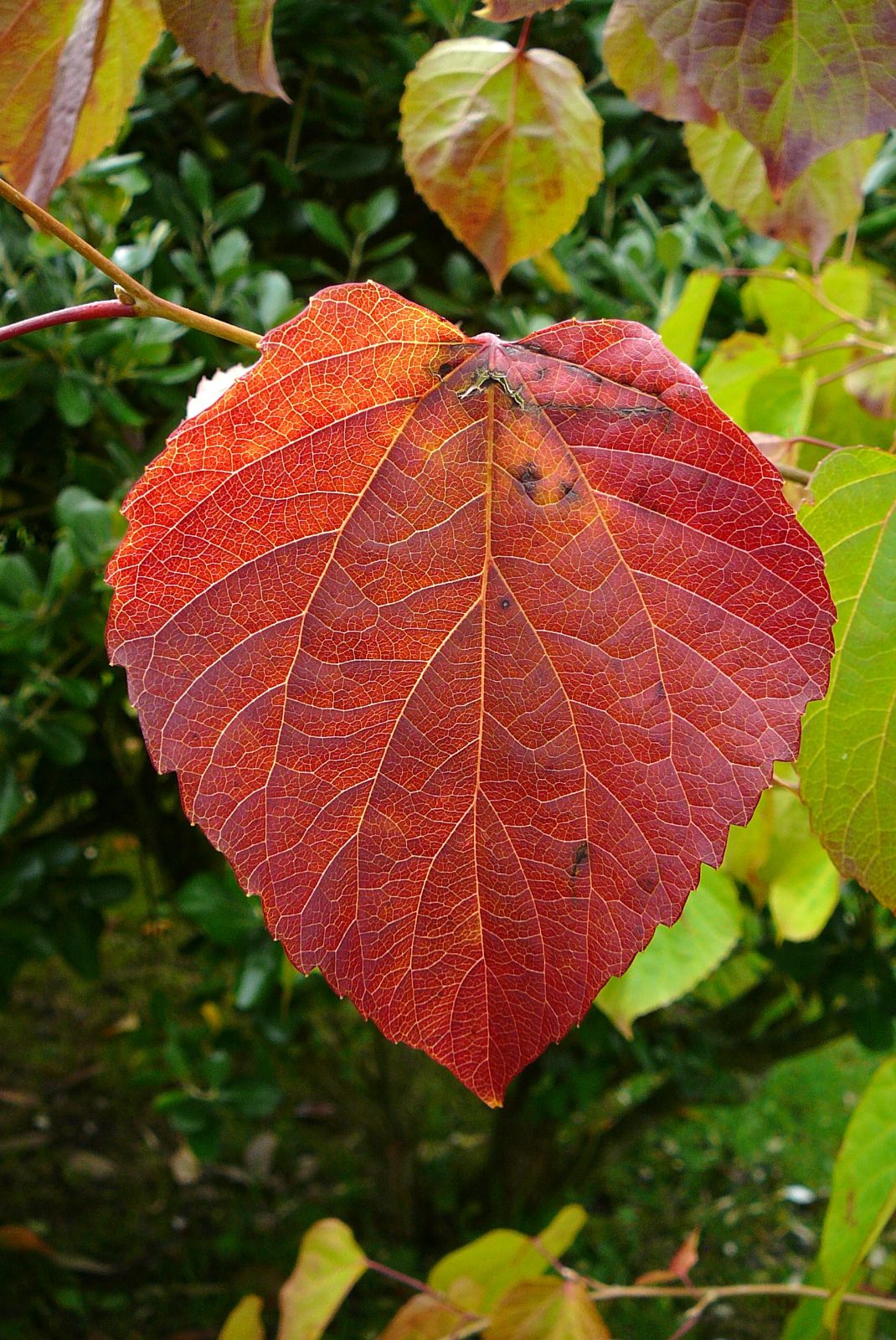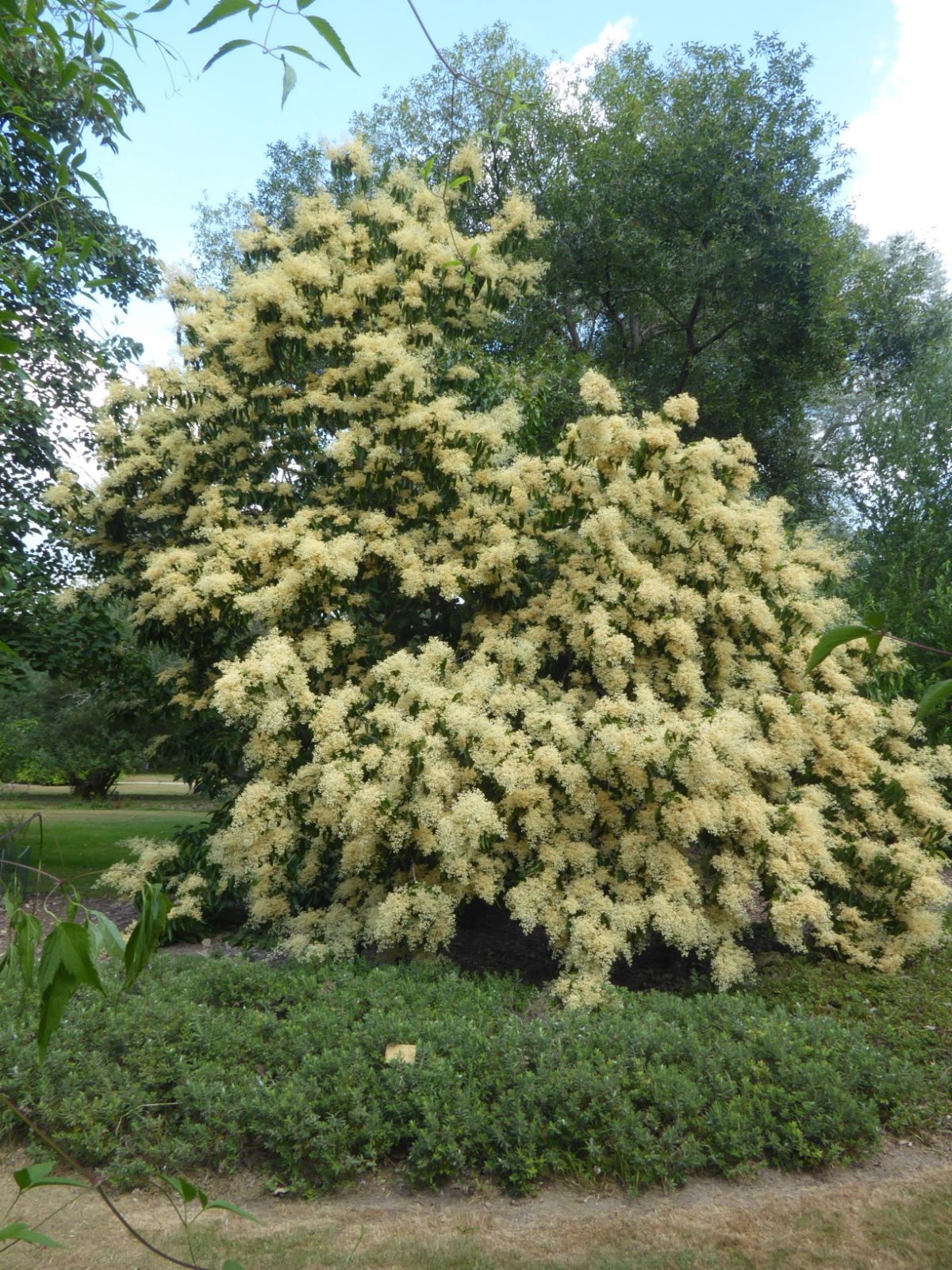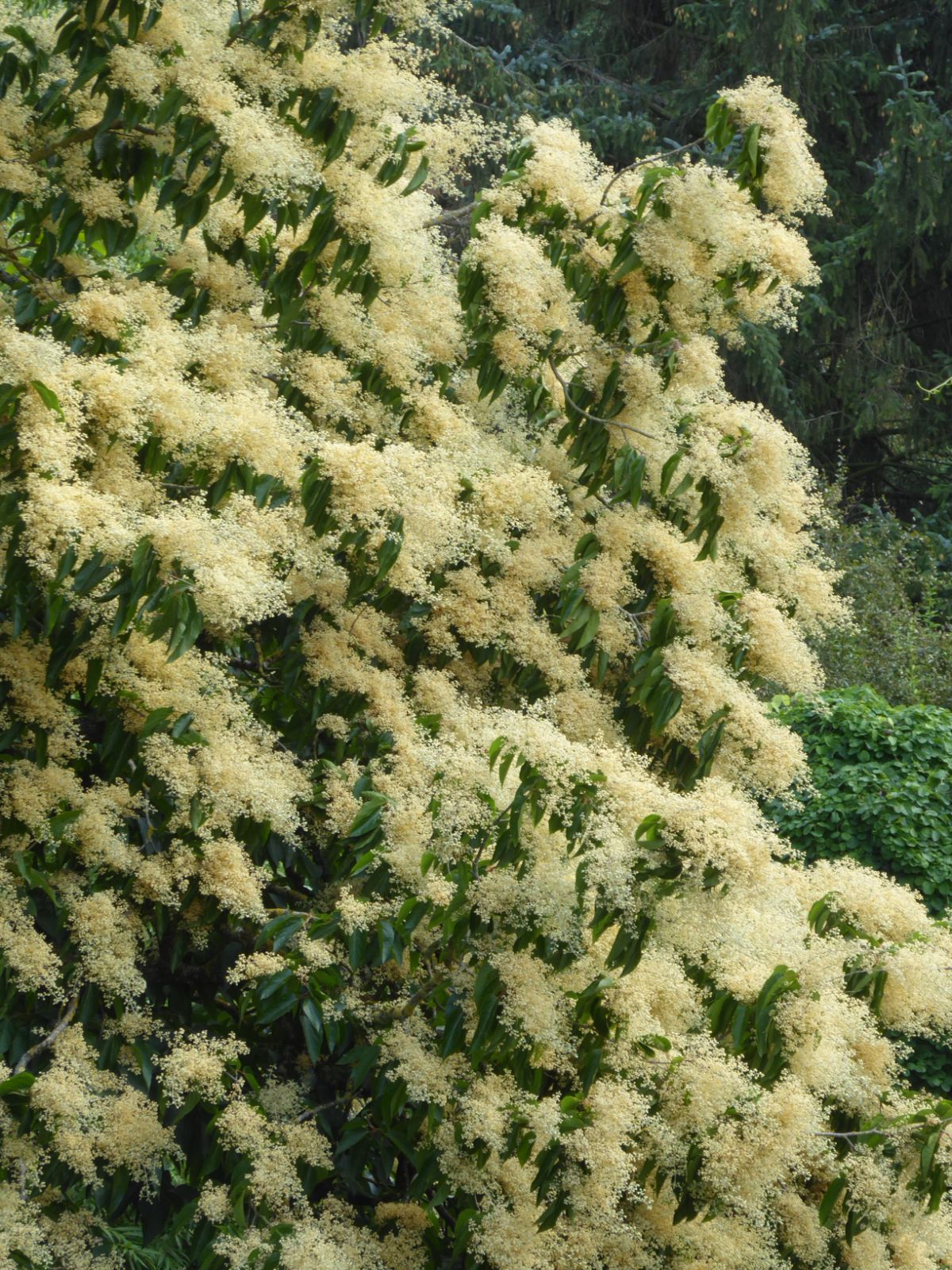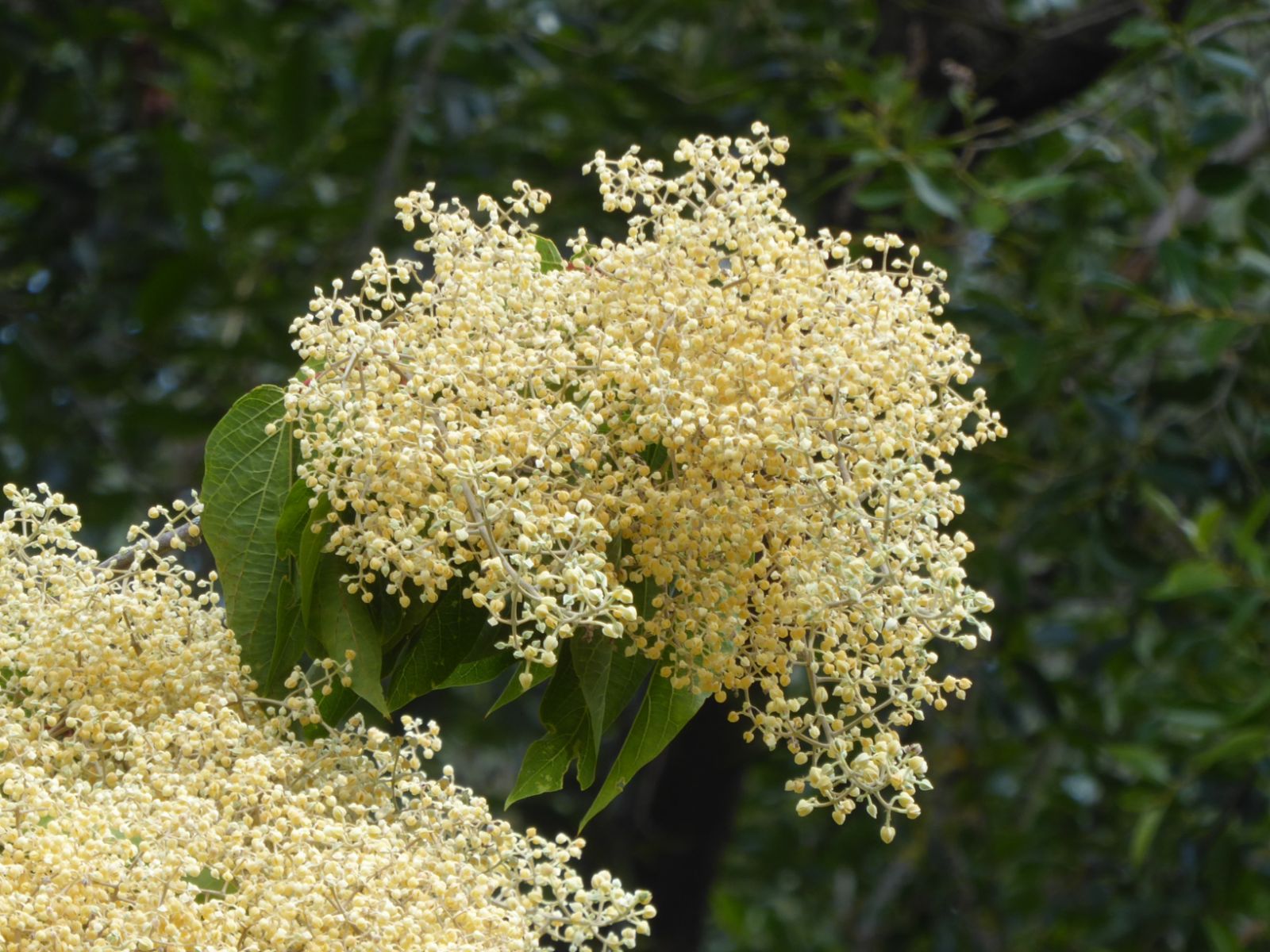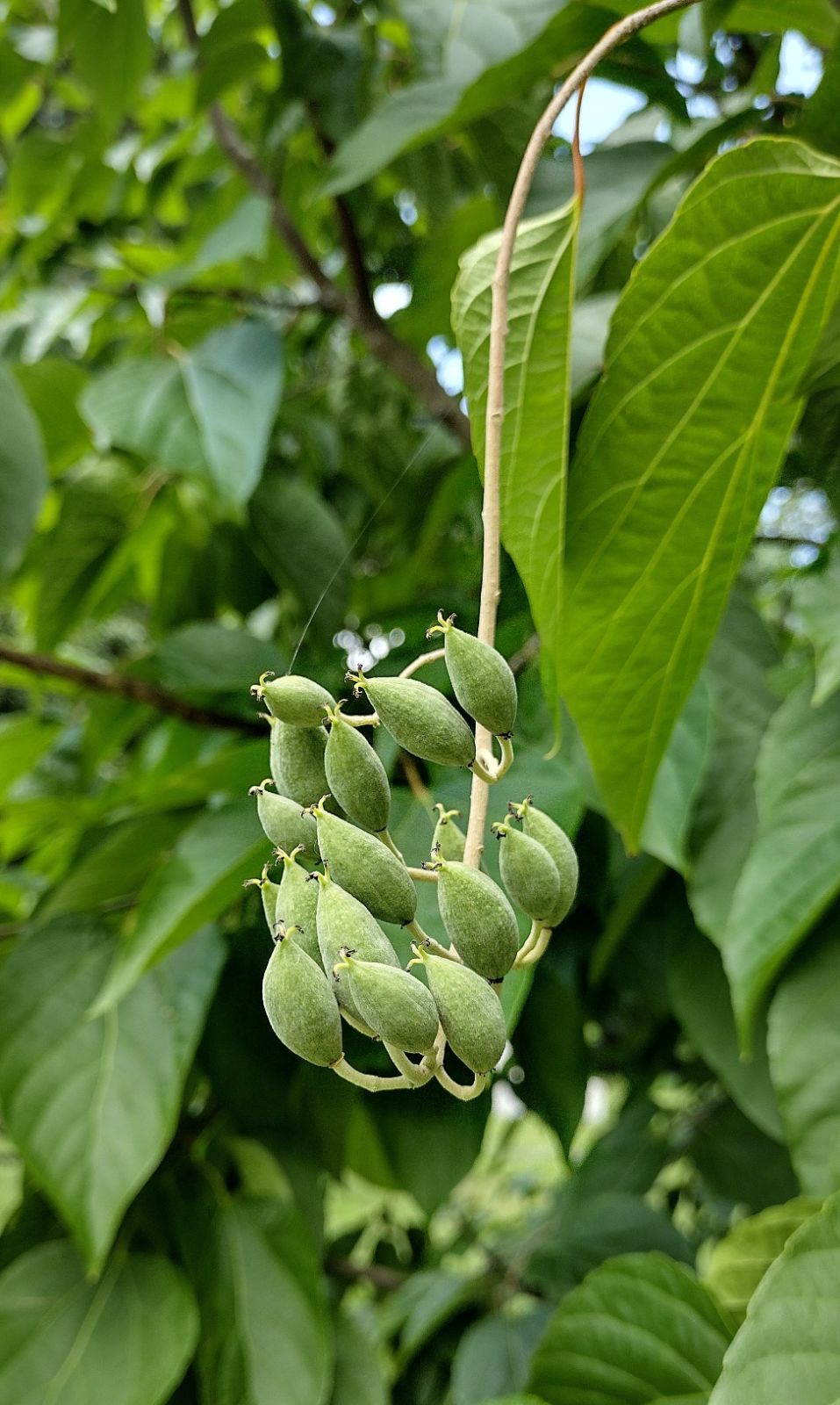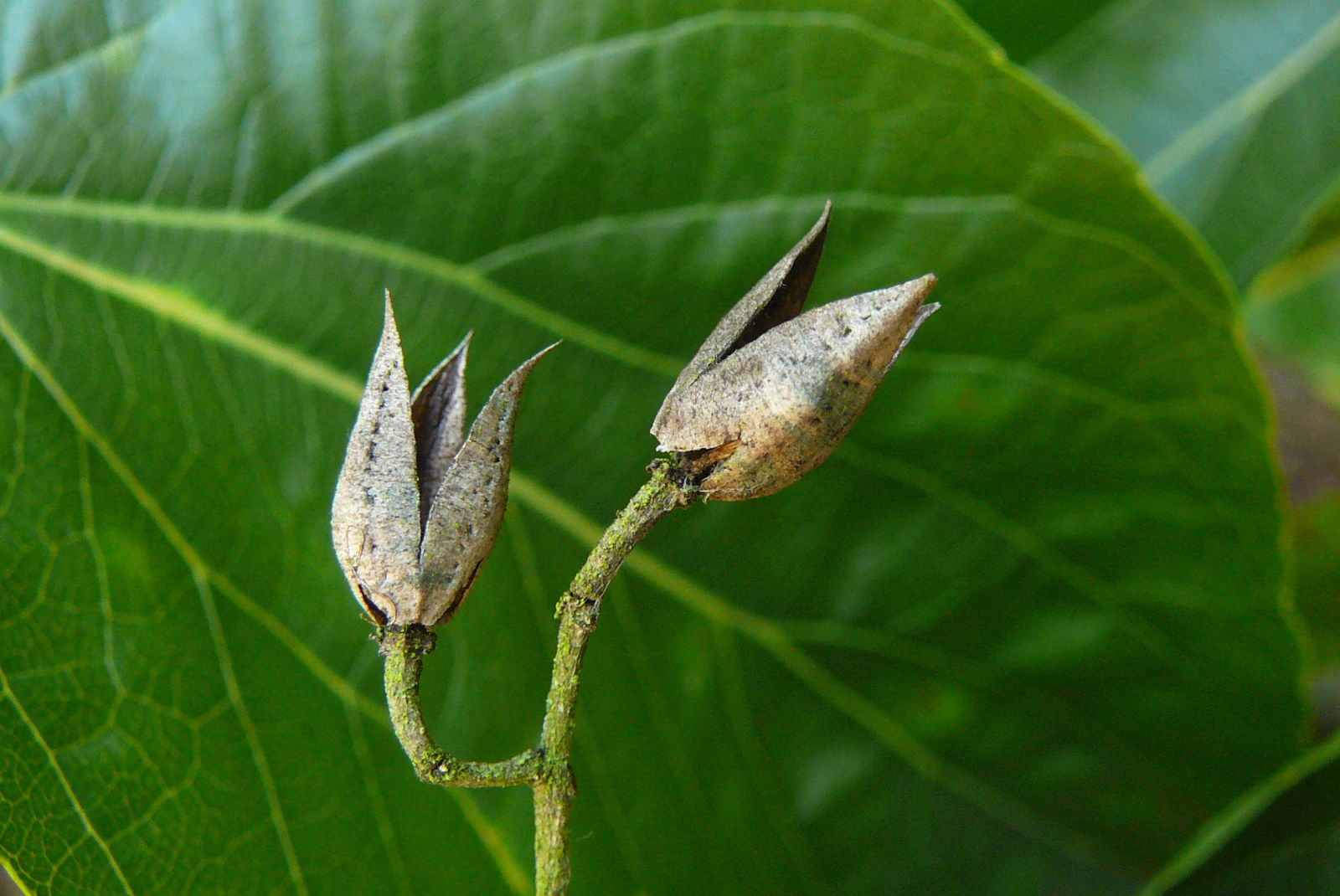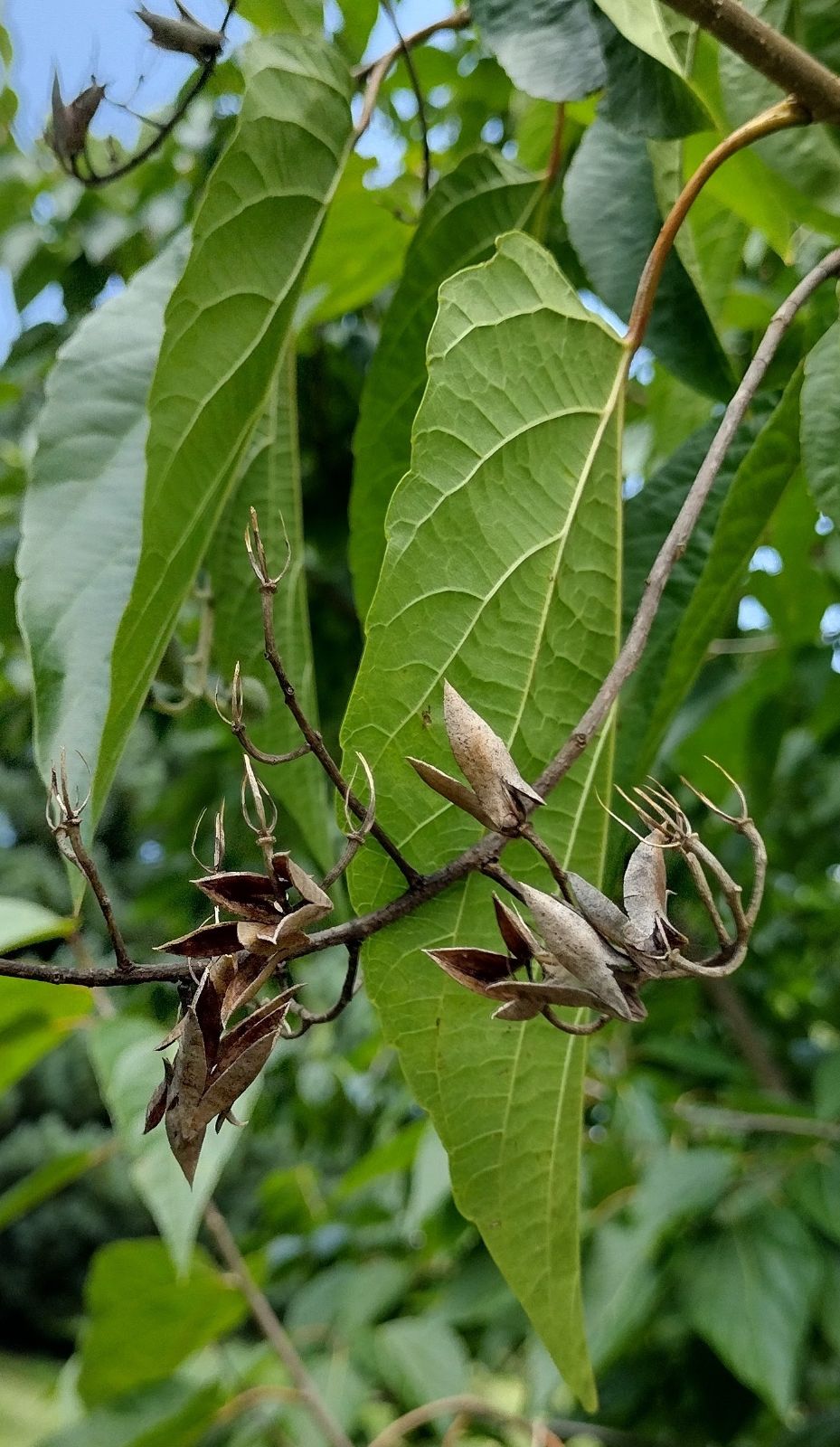Poliothyrsis sinensis
Sponsor
Kindly sponsored by
William & Griselda Kerr
Credits
Owen Johnson (2022)
Recommended citation
Johnson, O. (2022), 'Poliothyrsis sinensis' from the website Trees and Shrubs Online (treesandshrubsonline.
Genus
Common Names
- Chinese Pearlbloom
Other taxa in genus
A tree to 15 m tall with a rather dense and upright habit; sometimes bushy. Bark grey-brown, soon ruggedly fissured. Twigs grey, with short curled hairs at first. Leaves 8–18 × 4–10 cm, ovate to oblong or rarely cordate, dark shiny green above, pale green beneath; pubescent at first and remaining downy under the veins, which are in 5–6 pairs, with 3 or 5 veins from the base; base rounded to cordate, tip often long-pointed; margin glandular-serrate; petiole 2–6 cm, pubescent at first. Flower-head 10–20 cm high, with densely grey-woolly stalks. Sepals ovate, 4–5 mm long, densely grey-tomentose outside, glabrous inside, white then yellowish to orangish. Fruit capsule woolly, 2–3 × 1 cm; seeds with wings 5–10 mm wide. Flowers (in the wild) June–July, fruits July–September. (Flora of China 2022; Bean 1976).
Distribution China Anhui, Fujian, S Gansu, Guangdong, Guizhou, Henan, Hubei, Hunan, Jiangsu, Jiangxi, S Shaanxi, Sichuan, NE Yunnan, Zhejiang
Habitat Forests, 400 to 1500 m asl.
USDA Hardiness Zone 5
RHS Hardiness Rating H6
Conservation status Least concern (LC)
Poliothyrsis sinensis is one of those many species with plenty of features to recommend itself as a small to medium-sized garden tree, but with which few gardeners are familiar. In these respects it can be set alongside its close east Asian allies, Carrierea and Idesia; each has notably elegant leaves and scented flowers in large and quite showy panicles, followed by interesting fruit. Poliothyrsis is probably the toughest of this group and differs in its more compact habit and the rugged bark of mature plants; though the individual blooms are small the whole flowerhead with its light-trapping hairs is perhaps they showiest of these species, and has a scent sometimes compared to that of popcorn (Edwards & Marshall 2019), which attracts a hum of bees. The panicles are showy for several weeks before the flowers actually open; this is one of relatively few hardy trees to come into bloom in late summer, and is sometimes compared to Syringa reticulata, which tends to flower a fortnight earlier. Another unrelated tree with which it might easily be confused – out of fruit – is the Japanese Raisin Tree, Hovenia dulcis, whose flowerheads are rather smaller and whose three-veined leaves tend to have a distinctive morphology in which the margin meets the side veins a little above their point of divergence. In a continental climate, the autumn colour of Poliothyrsis can also be a good yellow or red, while the clear amber flush of several English specimens in mid-spring is another delight. American authorities tend to describe a reddish flush, and Baldwin (2019) describes it as scarlet on the Wilson original tree at Kew, though yellow is mentioned by Michael Dirr (Dirr 2009); the colour presumably depends on a combination of climatic and genetic features. The American botanist Stephen Spongberg, who was one of the first to extol this tree’s merits (Spongberg 1994), also commented on the attractiveness of the heads of light tan seed-pods. Spongberg at this stage lamented the lack of a vernacular name; ‘Chinese Pearlbloom’ has since been invented in the United States.
Harry Baldwin (2019) has recently elucidated the early history of Poliothyrsis in cultivation. Seed was sent by Augustine Henry to Kew soon after he discovered it in 1888, but the seedlings did not survive . Ernest Wilson collected seed for Veitch in 1901 and seedlings achieved an entry in the Veitch catalogue for 1906, but there is no further record of this introduction. A collection made for the Arnold Arboretum in 1908, under W 500, was slightly more successful. Seed was germinated there and at Kew, and distributed to other collections, but the Arnold’s plants were lost in the severe winter of 1918, and only one seedling survived at Kew after the sharp frost of 1909. This survives there, and inspired Baldwin’s 2019 article when it was noticed in 2018 that its flowers were orange, as opposed to the paler colour usually seen. Wilson himself noted that the flowers of W 500 were ‘nearly white’ (Sargent 1913). There is another Wilson original at Glasnevin, with similarly coloured flowers, and seedlings from the Kew tree have been distributed in recent years (Baldwin 2019).
Despite this rather uncertain start, Poliothyrsis seems to have been more or less continually available in the UK, most probably through the Hillier Nurseries, with accessions – at a time when scarcely any plant reintroductions were being made from China – at the Cambridge University Botanic Garden in 1961 and at Bradenham Hall in Norfolk in 1976. Another good planting from this period was a shapely survivor in 2004 from the collection created by Christopher Fraser-Jenkins at Newcastle House in central Bridgend, Glamorgan (Tree Register 2022).
By contract, Poliothyrsis seems to have died out in cultivation in the United States when the Arnold Arboretum’s stock was removed, for whatever reason, in 1933; the species was reintroduced to the Arboretum in the form of seed from the Shanghai Botanic Garden in 1981 (Spongberg 1994), and this is presumably the origin of today’s plants in American collections such as the Denver Botanic Gardens (Royal Botanic Garden Edinburgh 2022) and the J.C. Raulston Arboretum (Scott Arboretum of Swarthmore College 2022). As a monoecious tree, Poliothyrsis is rather easier than Carrierea or Idesia to propagate in cultivation and seems not to have been collected from China in much diversity in the last few decades, though in 2022 Pépinières Aoba in France advertised material from one Peter Cox and Steve Hootman collection, CH 6663 (Pepiniere Aoba 2022).
Unlike Carrierea and Idesia, Poliothyrsis seems more or less indifferent to soil quality and to pH, and is very drought-tolerant. Although hardy, it does need summer heat to flower and fruit well, and a 1936 accession at the Royal Botanic Garden Edinburgh was a rather poor four-metre bush which appeared moribund in 2009 (Tree Register 2022). The Tree Register’s champions do however include two from the warmer side of Ireland: a 13 m tree at Mount Congreve, and one 37 cm dbh (below the first fork) at Glasnevin National Botanic Gardens (Tree Register 2022). Genetic factors probably combine with climatic influences to determine whether the plant becomes a tree or remains a bush; several at the Scott Arboretum of Swarthmore College in Pennsylvania, received as seedlings from the J. C. Raulston Arboretum in 1993, had made shapely nine-metre trees after just 15 years (Scott Arboretum of Swarthmore College 2022). The rather narrow, straight-stemmed habit of these best plants, combined with the species’ general toughness, suggest that it might make an excellent street tree – but the economics of growing new taxa to large standard size means that, like so many other candidates, the Chinese Pearlbloom will probably never be given the chance to beautify and diversify our everyday urban environments in this way.
Even in today’s largest gardens, examples in fact remains scarce. This is not always an easy plant to grow, and the one planted by the author in his local park – in a bed with an apparently rather challenging soil – has so far languished. Online resources in 2022 indicate commercial availability in Poland and New Zealand, at least, and also reveal an unexpected but multi-stemmed plant, nine metres tall, in the Botanical Garden of Comenius University in Bratislava, Slovakia (monumentaltrees.com 2022).

